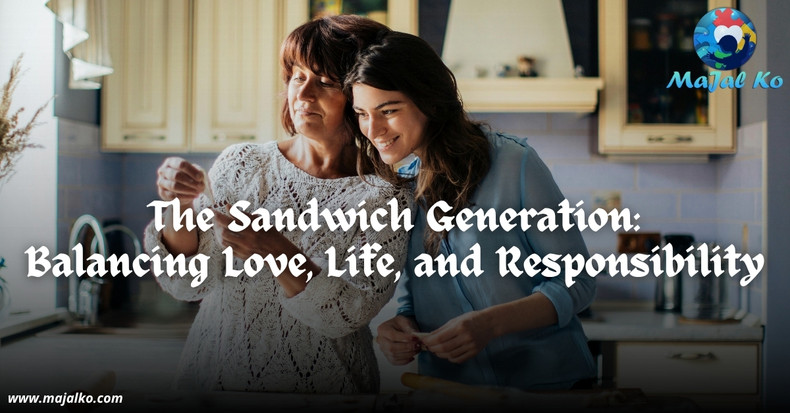The term "Sandwich Generation" refers to adults responsible for caring for both their aging parents and their own children. This challenge becomes even more complex when children have disabilities such as autism or Down syndrome, and elderly parents require increasing levels of care. Many caregivers in this situation struggle to balance their personal lives, careers, and relationships while meeting the needs of two dependent generations.
One of the most significant yet often overlooked aspects of this experience is the strain placed on marriages. Husbands and wives must navigate overwhelming responsibilities, financial pressures, and emotional stress while trying to maintain their relationship. Finding balance in this demanding role is crucial for both caregivers and their families.
The Unique Struggles of the Sandwich Generation
1. The Emotional Toll
Balancing the needs of dependent parents and children with disabilities can be overwhelming. Many caregivers experience chronic stress, anxiety, and even depression. The guilt of not being able to give enough time to either their parents or children leads to emotional exhaustion.
Research shows that caregivers of individuals with disabilities and elderly parents have higher rates of stress-related health issues (Pinquart & Sörensen, 2003). The constant worry about their loved ones' well-being, along with the unpredictability of medical and behavioral challenges, makes it difficult to find relief.
For married couples, this stress can lead to emotional distance, irritability, and communication breakdowns. When one partner feels neglected or unappreciated, resentment can build up, further straining the relationship.
2. Financial Pressures
Caregiving comes with significant financial burdens. Many caregivers must reduce work hours or leave their jobs entirely to provide full-time care. The costs of medical care, therapy, specialized equipment, and home modifications can be overwhelming. Meanwhile, elderly parents may require expensive treatments, in-home care, or assisted living, adding to the financial strain.
According to AARP, family caregivers spend an average of $7,242 annually on caregiving expenses (Rainville et al., 2016). Financial conflicts between spouses are common, especially when one partner takes on the majority of caregiving responsibilities while the other works.
3. The Physical Demands of Caregiving
Providing care for both elderly parents and disabled children is physically exhausting. Lifting, bathing, and assisting with mobility take a toll on a caregiver’s body, increasing the risk of injuries. Sleep deprivation is also common, particularly for those caring for children with autism, who may have irregular sleep patterns (Kotagal & Broomall, 2012).
For married couples, this exhaustion makes it difficult to support each other emotionally and physically. Intimacy often takes a backseat to caregiving responsibilities, leading to feelings of disconnect.
4. The Responsibilities of a Husband and Wife in the Sandwich Generation
In many families, caregiving duties are not evenly distributed between spouses. Often, the wife takes on the majority of the caregiving, leading to feelings of isolation and burnout, while the husband may feel pressure to provide financial stability.
Common challenges couples face include:
-
Division of labor – One spouse may feel overwhelmed by caregiving while the other focuses on work, leading to resentment.
-
Lack of time together – Date nights and quality time are often sacrificed.
-
Different coping mechanisms – One partner may want to talk about stress, while the other withdraws.
-
Decision-making conflicts – Disagreements about medical care, living arrangements, or finances can create tension.
5. Navigating Medical and Legal Complexities
Caregivers must coordinate multiple medical providers, therapies, and treatments for both generations. Understanding health insurance, disability benefits, and legal guardianship can be overwhelming.
For married couples, these responsibilities can cause tension, especially if one partner feels they are shouldering more of the burden. Couples must communicate and plan together regarding medical decisions, financial security, and legal preparations.
Coping Strategies for the Sandwich Generation
1. Seeking Support
Building a strong support network is essential. Caregivers should reach out to family, friends, and support groups. Online communities and caregiver networks can provide emotional support and practical advice.
Respite care services offer temporary relief, giving caregivers a much-needed break. Programs like Medicaid’s Home and Community-Based Services (HCBS) help provide in-home support for disabled individuals and elderly parents.
2. Strengthening the Marriage
To prevent caregiving stress from damaging their relationship, couples can:
-
Schedule time together – Even small moments like morning coffee can help maintain connection.
-
Divide responsibilities fairly – Open discussions about caregiving tasks can prevent resentment.
-
Seek counseling – A therapist can help navigate challenges and improve communication.
-
Express gratitude – Appreciation for each other’s efforts strengthens emotional bonds.
3. Financial and Legal Planning
Consulting a financial planner or elder care attorney can help caregivers navigate expenses. Special needs trusts, long-term care insurance, and estate planning provide financial security.
4. Prioritizing Self-Care
Caregivers often neglect their own health, but self-care is essential. Even small efforts, such as regular exercise, relaxation, or hobbies, can make a difference. Joining a caregiver support group can help manage emotional stress.
5. Utilizing Community Resources
Many nonprofit organizations and government programs offer support for both disabled children and elderly parents. The National Alliance for Caregiving and the Administration for Community Living provide helpful resources.
Conclusion
The Sandwich Generation faces immense challenges in balancing love, life, and responsibility. Caring for both disabled children and aging parents requires emotional resilience, financial planning, and physical endurance. The added strain on marriages can make these challenges even more difficult.
However, with open communication, a strong support network, and intentional self-care, caregivers can navigate this season while preserving their relationships and well-being. No one should face these challenges alone—help is available for those who seek it.
References
-
Kotagal, S., & Broomall, E. (2012). Sleep in children with autism spectrum disorder. Pediatric Neurology, 47(2), 91-100.
-
Pinquart, M., & Sörensen, S. (2003). Differences between caregivers and non-caregivers in psychological and physical health: A meta-analysis. Psychology and Aging, 18(2), 250-267.
-
Rainville, C., Skufca, L., & Mehegan, L. (2016). Family caregivers cost survey: What they spend & what they sacrifice. AARP Public Policy Institute.

